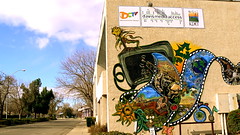 Gracias a Jesús y Kate para su visita, su visión, su pasión para justicia, y para esta pintura mural hermosa. Esto es un regalo durable a la gente de Davis, y esperamos que esto cause la amistad durable y la unión con la gente de Oaxaca.
Gracias a Jesús y Kate para su visita, su visión, su pasión para justicia, y para esta pintura mural hermosa. Esto es un regalo durable a la gente de Davis, y esperamos que esto cause la amistad durable y la unión con la gente de Oaxaca.
Note: This column was originally published in The Davis Enterprise on October 25, 2008.
I can’t tell you how many times I’ve stared at the large, blank wall on the east side of the Davis Media Access (DMA) building on Fifth Street. Beige, bland and empty except for a sign that still needs to be updated (note: it's been updated, Oct. 15--check it out!), I’ve long thought the wall is just crying out for a mural. But it’s one of those projects we have perpetually put off in the face of more pressing needs at this community media center.
That is, until this week. As I write, the work to create a mural here has begun. The circumstances that have led to this are quite remarkable. A friend of one our staff members knows a mural artist from Oaxaca, Mexico, who is traveling to raise awareness about government repression and community organizing in this southern state in Mexico. In Davis for just a short time, Jesús has offered to paint a mural depicting community, media and their place here in Davis.
He specifically wanted to gift us with this mural because of the history in Oaxaca. During the latter half of 2006, a teacher’s strike began a complex chain of events that eventually led to the Oaxacan people taking over the state-run TV and radio stations when they tired of the truth not being disseminated. In the intervening months, martial law was imposed upon Oaxaca, hundreds were killed—not only Oaxacans, but an Indymedia journalist from New York City named Bradley Will. Will’s death actually turned the world’s focus to Oaxaca for one brief moment in July of that year.
Oaxaca’s story is one that has been played out in nearly every developing nation: resources plundered, indigenous peoples marginalized. What was significantly different here was the way people viewed the media, and the ways in which they used media to organize for social change. To them, media was a tool for disseminating information, not for manufacturing content. When they (peacefully) took over the radio and TV stations, it was to talk about the number of Oaxacan children who go hungry, or the need for medical and teaching supplies. As the military bore down on them, radio and television became a means to organize neighborhood barricades to keep the people safe. All of this and more is detailed in an excellent documentary called Un Poquito de Tanto Verdad (A Little Bit of So Much Truth). [Note; we screened this film on Oct. 5 at DMA to a full house.]
If you read this column regularly, you will know that I have been writing for years about the community building and social change work DMA does. It is no coincidence that the slogan for our upcoming 20th anniversary celebration is “Celebrating 20 Years of Creating Community Through Media.” That celebration is rapidly approaching, and to have this mural unfolding at this time, and in this particular context, has moved me deeply.
It is also been a crazy process. I find myself scrambling daily to round up needed supplies, such as scaffolding and paint, and to find housing, meals and connections for our visitors. I would like to thank in particular Kristen Koster, Mulysa Wagner and Diane Crumley for their tremendous organizing efforts, and of course Jesús and his partner Kate. By the time this project is done, I know there will be a long list of businesses and individuals to thank. In the meantime, if you’re driving west on Fifth Street, look up as you pass by the building at 1623. It’s at the intersection of art, community and media. --Autumn Labbe-Renault
